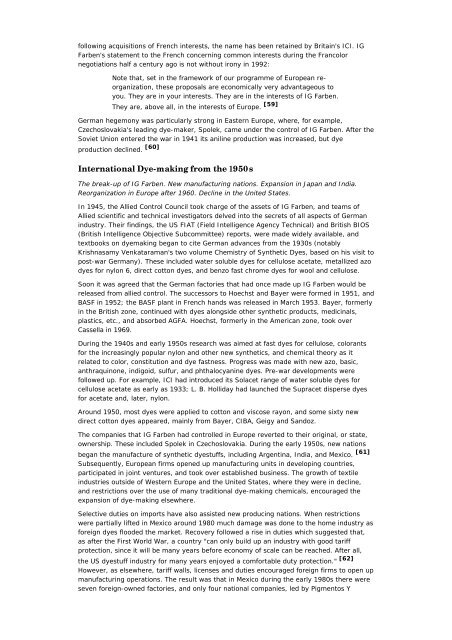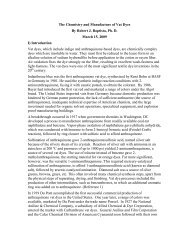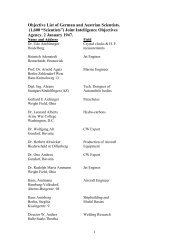International Dyestuff Industry - ColorantsHistory.Org
International Dyestuff Industry - ColorantsHistory.Org
International Dyestuff Industry - ColorantsHistory.Org
Create successful ePaper yourself
Turn your PDF publications into a flip-book with our unique Google optimized e-Paper software.
following acquisitions of French interests, the name has been retained by Britain's ICI. IG<br />
Farben's statement to the French concerning common interests during the Francolor<br />
negotiations half a century ago is not without irony in 1992:<br />
Note that, set in the framework of our programme of European reorganization,<br />
these proposals are economically very advantageous to<br />
you. They are in your interests. They are in the interests of IG Farben.<br />
They are, above all, in the interests of Europe. [59]<br />
German hegemony was particularly strong in Eastern Europe, where, for example,<br />
Czechoslovakia's leading dye-maker, Spolek, came under the control of IG Farben. After the<br />
Soviet Union entered the war in 1941 its aniline production was increased, but dye<br />
production declined. [60]<br />
<strong>International</strong> Dye-making from the 1950s<br />
The break-up of IG Farben. New manufacturing nations. Expansion in Japan and India.<br />
Reorganization in Europe after 1960. Decline in the United States.<br />
In 1945, the Allied Control Council took charge of the assets of IG Farben, and teams of<br />
Allied scientific and technical investigators delved into the secrets of all aspects of German<br />
industry. Their findings, the US FIAT (Field Intelligence Agency Technical) and British BIOS<br />
(British Intelligence Objective Subcommittee) reports, were made widely available, and<br />
textbooks on dyemaking began to cite German advances from the 1930s (notably<br />
Krishnasamy Venkataraman's two volume Chemistry of Synthetic Dyes, based on his visit to<br />
post-war Germany). These included water soluble dyes for cellulose acetate, metallized azo<br />
dyes for nylon 6, direct cotton dyes, and benzo fast chrome dyes for wool and cellulose.<br />
Soon it was agreed that the German factories that had once made up IG Farben would be<br />
released from allied control. The successors to Hoechst and Bayer were formed in 1951, and<br />
BASF in 1952; the BASF plant in French hands was released in March 1953. Bayer, formerly<br />
in the British zone, continued with dyes alongside other synthetic products, medicinals,<br />
plastics, etc., and absorbed AGFA. Hoechst, formerly in the American zone, took over<br />
Cassella in 1969.<br />
During the 1940s and early 1950s research was aimed at fast dyes for cellulose, colorants<br />
for the increasingly popular nylon and other new synthetics, and chemical theory as it<br />
related to color, constitution and dye fastness. Progress was made with new azo, basic,<br />
anthraquinone, indigoid, sulfur, and phthalocyanine dyes. Pre-war developments were<br />
followed up. For example, ICI had introduced its Solacet range of water soluble dyes for<br />
cellulose acetate as early as 1933; L. B. Holliday had launched the Supracet disperse dyes<br />
for acetate and, later, nylon.<br />
Around 1950, most dyes were applied to cotton and viscose rayon, and some sixty new<br />
direct cotton dyes appeared, mainly from Bayer, CIBA, Geigy and Sandoz.<br />
The companies that IG Farben had controlled in Europe reverted to their original, or state,<br />
ownership. These included Spolek in Czechoslovakia. During the early 1950s, new nations<br />
began the manufacture of synthetic dyestuffs, including Argentina, India, and Mexico. [61]<br />
Subsequently, European firms opened up manufacturing units in developing countries,<br />
participated in joint ventures, and took over established business. The growth of textile<br />
industries outside of Western Europe and the United States, where they were in decline,<br />
and restrictions over the use of many traditional dye-making chemicals, encouraged the<br />
expansion of dye-making elsewhere.<br />
Selective duties on imports have also assisted new producing nations. When restrictions<br />
were partially lifted in Mexico around 1980 much damage was done to the home industry as<br />
foreign dyes flooded the market. Recovery followed a rise in duties which suggested that,<br />
as after the First World War, a country "can only build up an industry with good tariff<br />
protection, since it will be many years before economy of scale can be reached. After all,<br />
the US dyestuff industry for many years enjoyed a comfortable duty protection." [62]<br />
However, as elsewhere, tariff walls, licenses and duties encouraged foreign firms to open up<br />
manufacturing operations. The result was that in Mexico during the early 1980s there were<br />
seven foreign-owned factories, and only four national companies, led by Pigmentos Y





